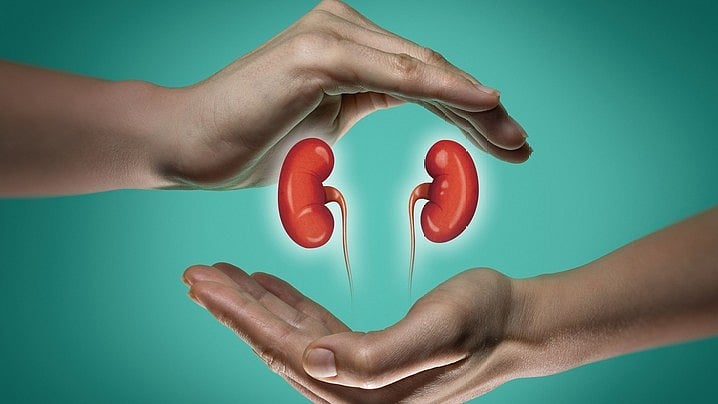
Representative image of kidneys.
Credit: iStock Photo
By Lisa Jarvis
Xenotransplantation, the futuristic sounding field of animal-to-human organ transplants, is suddenly a lot closer to reality. The first two gene-edited pig kidneys have been transplanted into humans— and, so far, seem to be working beautifully.
It’s an astonishing advance in a field that has languished for years. It’s also priming a race between companies in the field. Who will be first to convince the world their technologies are the most viable?
Last fall, researchers offered evidence that these pig organs could work in the long term— in monkeys, at least. One monkey lived for two years after receiving an organ developed by eGenesis, a biotech firm cofounded by Harvard bioengineer George Church. That added to several studies suggesting pig organs were functional for short stints when transplanted into brain-dead people who had donated their bodies to science.
Then last month, eGenesis provided a kidney to Richard Slayman. After being treated for an early sign of rejection, he was able to leave Massachusetts General Hospital, whose surgeons performed the transplant, just two weeks later. It was a stunning turnaround for the 62-year-old Massachusetts man, who had four years earlier received a human kidney that was failing.
Due to a raft of other health problems, he had just a 16 per cent chance of getting a transplant within the next five years, says one of his doctors, Winfred Williams, associate chief of MGH’s nephrology division.
Now we’ve got a second success story, this time with a pig kidney developed by United Therapeutics Corp. Like Slayman, New Jersey resident Lisa Pisano was “very ill and caught in a medical Catch-22,” Robert Montgomery, the director of the NYU Langone Transplant Institute, where the surgery was performed, told reporters.
Both her heart and kidney were failing, yet her other health conditions kept her off the organ donation list. And although a medical device called an LVAD (left ventricular assist device) could have helped pump blood from her heart to the rest of her body, it’s not been an option for someone on dialysis— the mortality rate is too high. That left Pisano with weeks to live.
The 54-year old became the first person ever to undergo a combined heart pump and pig kidney transplant. Nearly two weeks later, the organ seems to be working beautifully and she’s shown no signs of rejecting it. Talking to reporters via Zoom from her hospital bed, Pisano said, “I feel fantastic. I feel the best I’ve felt in a long time.”
Slayman and Pisano’s plights are faced by far too many people. They are too sick to be eligible for an organ donation, or one doesn’t arrive in time. And on a more basic level, there just aren’t enough organs to go around. According to the Organ Procurement and Transplant Network, nearly 90,000 people are currently waiting for a kidney. Williams says that people with certain blood types might wait on average for six to seven years for a kidney— and too often one doesn’t come in time.
The next few months will be an important test for whether pig kidneys can dispatch with those long waits. Doctors will be watching to see whether the patients’ immune systems continue to tolerate the organs.
They will also be watching whether one organ does better than the other. Slayman’s pig kidney features a whopping 69 edits, most of which are intended to turn off genes that might put him at risk of infection.
By contrast, the organ that Lisa Pisano received had just a single gene edit. It was intended to knock out a sugar sitting on the surface of pig cells that triggers an immune reaction. Her kidney also had tissue from the pig’s thymus grafted to it, a modification intended to help train the recipient’s immune system to be tolerant of the pig kidney. Ultimately, the hope is that the addition of the thymus allows recipients to be weaned from some of the powerful immunosuppressant drugs that follow transplants.
The two strategies (and others in development, including a pig kidney from United Therapeutics with 10 gene edits) have sparked a debate about whether less is more (or more is more) when it comes to gene edits intended to make these organs safer. The goal is to provide an organ that properly functions, while minimizing the risks of rejection and maximizing long-term safety.
The next step will be clinical trials. Williams believes that if Slayman’s pig kidney keeps him stable and continues to look safe over the next six months to a year, it’s time for the Food and Drug Administration to allow formal studies to move forward. That’s a sentiment echoed by United Therapeutics, which believes it might be allowed to start clinical trials of its pig kidneys next year.
No matter which technology wins— and I hope there is not just one winning strategy, but several— it’s important to stay focused on the ultimate prize: a world where no one has to die waiting for a donor.
And of course, we can’t overlook the true pioneers here: Pisano and Slayman. It’s no small thing to step up to be the first. While of course they were hoping for more time with their families, they knew there was a reasonable chance of a grimmer outcome. They also understand their important role in medical history. As Pisano told reporters, “The worst-case scenario, if it doesn’t work, it might work for the next person.”